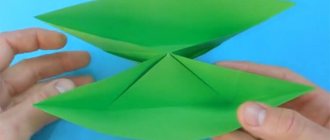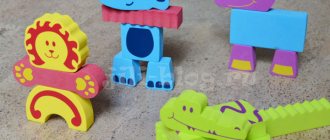Preview:
Municipal state preschool educational institution kindergarten No. 5 “Rodnichok”
Peskovka village, Omutninsky district
Summary of a lesson on artistic design with children of senior preschool age
Author - Tarasova Galina Petrovna,
teacher of the highest qualification category.
Contact phone: 88335236753
Summary of a lesson on artistic and decorative design in a preparatory school group.
Theme: “House is a flower” (spatial - decorative design)
Objectives: 1. Teach children to create jewelry from their chosen artistic material. 2.Develop the ability to decorate products. 3. Develop imagination, aesthetic taste, accuracy. 4. Develop coherent speech, using the text of a fairy tale as a model.
Material: Illustration material “Flowers”
Cardboard box, gouache, felt-tip pens, pencil, brushes, wax crayons, PVA glue, napkins, polystyrene foam, pieces of fabric, sequins, beads, natural materials, colored paper. CD “Magic Sounds of Nature”
Preliminary work: Making attributes for the dance composition “Flowers”. Making the cone theater “Thumbelina”. Labor in nature: caring for flowers. A story about useful and dangerous flowers. Reading a fairy tale by G.Kh. Andersen "Thumbelina"
The buzzing of insects can be heard in the group. (CD “Magic Sounds of Nature”), the teacher invites the children to go around the room and find the source of the sound. Characters from the fairy tale “Thumbelina” are found in a pot with an indoor flower.
The teacher reads excerpts from this fairy tale:
There lived one woman in the world. She didn't have children, but she really wanted a baby. So she went to the old witch and said:
“I really want to have a daughter, even the smallest one.”
- What’s easier! - answered the witch. - Here's some barley grain for you. This grain is not simple, not the kind that ripens in your fields and is born as food for birds. Take it and plant it in a flower pot. You'll see what happens. - Thank you! - said the woman and gave the witch twelve coppers. Then she went home and planted a grain of barley in a flower pot. As soon as she watered it, the seed immediately sprouted. Two leaves and a tender stem appeared from the ground. And on the stem a large wonderful flower appeared, like a tulip. But the flower's petals were tightly compressed: it had not yet bloomed.
- What a lovely flower! – the woman said and kissed the beautiful colorful petals. At that very moment, something clicked in the core of the flower, and it opened. It was, in fact, a large tulip, but in its cup sat a living girl. She was tiny, tiny, only an inch tall. That's why they called her that - Thumbelina...
The teacher invites the children to independently remember the content of the work. Sample stories from children: Thumbelina is a tiny girl who goes through many trials. She escapes from the frog, but falls straight into the clutches of the cockchafer, who soon abandons her and the poor girl is left alone in the forest. Thumbelina has a kind heart, because she saves herself and also saves the swallow, who takes her to warmer climes to a flower, where the baby meets the king of the elves.
Holding fairy tale characters in their palms, children act out fairy tale dialogues. Motivation: But the fairytale guests are in a bad mood, they have nowhere to live. The children offer to make a home for the heroes, and they will stay with them in the group.
The teacher creates a problematic situation: what can we make housing from so that it is comfortable, separate, beautiful, and functional?
Children disperse into groups, find objects suitable for guests to live in and explain their choice.
The teacher suggests that the most ordinary cardboard box is suitable for this. It can be designed in the form of a flowering meadow, and voluminous flowers will serve as a home. Children look at pictures of flowers, choose the most beautiful and comfortable flower to live in (a dense bud, tall and wide petals, a lot of pollen for a feather bed, etc.)
The teacher and children jointly create a collective sketch of the scene - background (gouache, felt-tip pens, crayons)
Children are divided into groups and distribute the work themselves (background, grass, pebbles, small volumetric flowers, a palace in the form of a large volumetric flower).
Together with the teacher, they recall the technology of making flowers from paper (origami), grass, stones, leaves (3-dimensional applique)
After completing the main work, decorate with additional artistic material.
The teacher invites you to admire the beauty and fabulousness of the work performed. Children help fairy-tale characters “choose and move into” ready-made houses—flowers. They organize a “Ball among Flowers”.
Bibliography.
- G. H. Andersen fairy tale “Thumbelina”
- Z.V. Bogateev “Wonderful paper crafts” publishing house “Prosveshcheniye” 1992
- I.A. Lykova “Visual activities in kindergarten”, publishing house “Sfera”, 2007.
- G.N. Panteleev “Children’s Design” publishing house “Karapuz” 2006
- THEM. Petrova “Applique for preschoolers” publishing house “CHILDHOOD - PRESS” 2007
Summary of educational activities in the senior group on the topic “Houses are different”
Municipal state-owned preschool educational institution, a general developmental kindergarten with priority implementation of activities in the artistic and aesthetic direction of children's development
No. 7 “Kolosok”, Blagodatnoe village, Petrovsky urban district, Stavropol Territory
Summary of educational activities
in the senior group
on the topic “ Houses are different ”
Educational field “Artistic and aesthetic development”.
Prepared by:
Deputy Head of VMR
MKDOU DS No. 7 “Spikelet” Puneva T.I.
04/18/2018
Blagodatnoe village
Objectives in the priority educational area “Artistic and aesthetic development”:
improving the ability to make sketches in pencil followed by painting with visual materials; reinforce how to make a sketch with a simple pencil, teach carefully, without going beyond the outline, and paint over the image without gaps with materials of the children’s choice.
Objectives of OO in integration:
"Cognitive development":
help expand children's knowledge about types of houses, their
designs
, continue to introduce various building materials and construction professions; develop cognitive activity, thinking, memory, attention.
“Social and communicative”:
cultivate goodwill, the desire to always come to the rescue; develop the skills of cooperation in pairs, independence, initiative; promote the development of interest in the profession of an architect, in visual arts, and evoke a desire to use different visual materials.
to instill in children the desire to finish what they start and to be careful when doing work.
“Speech development”:
improve the ability to listen carefully and hear a question, answer with a complete answer; develop a dialogical form of speech.
"Physical development":
develop coordination of speech with movement.
Creating an environment for organizing and conducting educational activities
: finished sample, reference diagrams, images of houses, letter; musical accompaniment, presentation of “At Home”; sample teacher (house), reference diagrams for drawing (various modifications of windows, doors, roofs), graphite pencil, eraser, paints, wax crayons, colored pencils, felt-tip pens (children's choice), illustrations depicting various buildings.
Preliminary work:
excursion around the village, looking at houses, reading fiction on the topic “My Home
”
, looking at illustrations, postcards.
Vocabulary work:
clarification and activation in speech of the words drawing, architect, project, builder, painter, interstellar Galaxy.
Prerequisites for educational activities:
use different colors and shades to express an image, are able to compose compositions, act with concentration during class, independently select the necessary visual material, and are able to focus on a diagram.
Organization of educational activities
I. _ Organizing time.
1. Creating gaming motivation.
Educator: Guys, today a letter arrived at our address. I just can’t figure out who it’s from. The teacher reads out the contents of the letter: “We, scientists of the interstellar Galaxy, have discovered a new, as yet uninhabited planet on which people could settle. We heard that there are many talented people in your city of Masters, so we ask you to help us improve the territory. We have many builders, but no architects. Help".
Educator: Guys, what do you think we can help the scientists of the interstellar Galaxy? But as? (children's answers).
II . Main part.
Educator: Yes, guys, the task is not easy, but I think that we will definitely cope with it.
It is very difficult for living beings without a home
Birds, animals, insects need housing
Living creatures without a home are in trouble
But people without a home are absolutely nowhere.
- Conversation about architects.
Educator: Let's remember who architects are and what they do. What is a project? (Children's answer options).
Educator:
If you build a new house
For people to live in it
You need knowledge to have
And master the profession.
What should an architect think about before putting a drawing to paper? What will the house be like? How many floors will the house have? What shape and size will the windows and doors be? What material will the house be built from? What should every architect know? (Children's answer options).
- Examination of the subject - at home.
Educator: Guys, name each part of the house and answer what it is needed for.
Educator: Every house has walls. What can we say about them? (Children's answer options).
The house has a strong wall,
Definitely needed
Because we are behind her
We feel stronger.
Educator: The next part of the house is the roof. Describe her. (Children's answers).
Roof for the house - headdress
It will cover the building like a big hat.
Educator: The house has windows. What can we say about them? (Children's answer options).
Educator: What very important part of the house have we not yet mentioned? What shape is the door? (Children's answer options).
Educator: Guys, let's remember what building material you might need to build a house?
- Didactic game “From what?”
Educator: To build a log house, you will need... logs.
To build a brick house, you will need... To build a block house, you will need....
Educator: Guys, we are convinced that you have all the necessary knowledge to create a house project, it remains to check whether you have enough strength and dexterity to complete it?
- Physical education
5. Independent activity of children.
Educator: Developing a drawing of a future home is a very difficult job and you need to approach it with all responsibility. So, let's remember where to start doing the work? (Children's answers).
Educator: Let's try to turn your sheets of paper into the house of your dreams. Try to draw a beautiful, solid structure.
Educator: Well done, guys, everyone coped with the task! Real architects.
6. Analysis of drawings. Children's works are put on display. I draw attention to the painted houses. What was difficult for you? Why do you think you were able to help the scientists of the interstellar Galaxy? (Children's answer options). Children pack their finished works into a box and mail them to scientists.
III . Reflection.
Educator: Guys, who did we help today? (Scientists of the interstellar Galaxy). What was difficult for you? Why do you think you were able to help scientists?






